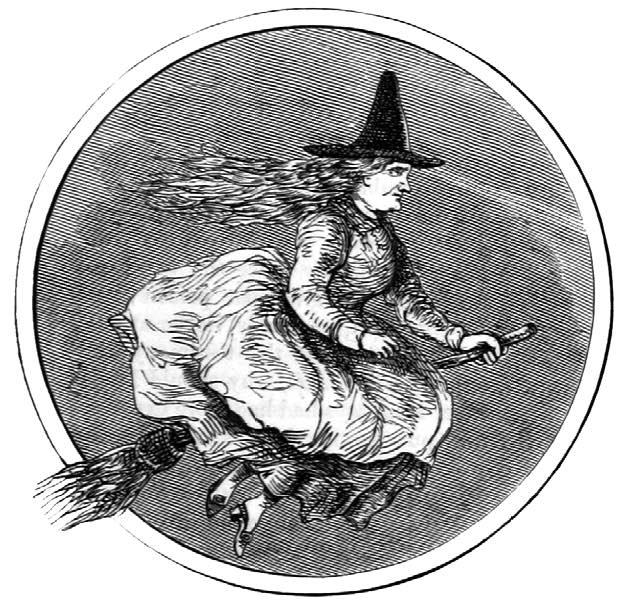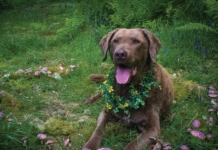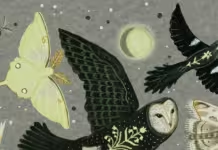
I’ve lived many places, but thus far Salem, Massachusetts, was the only one where no one ever asked where I’d come from. There are some places you inhabit, and there are some places that inhabit you. Every now and then the stars align and the two meet as one. I moved to Salem in the summer of 1995, knowing nobody in the area, with no leads on a place to live, my only income from a self-produced catalog of handcrafted gothic fashions founded a year prior. Arriving on a whim, my partner and I walked past quaint brick-walled shops on Essex Street with stained glass stars glinting in the windows, with Celtic strains of Loreena McKennitt and gentle clouds of intoxicating incense floating through the air. I read the names of the 1692 witch trial victims embedded in glowing crimson in the floor of the Salem Witch Museum, took in a larger-than-life painted mural of a witch gracefully overlooking her seaside domain at Salem Witch Village, and knew I’d found my new hometown. Sadly, there weren’t any affordable places to live available, and after spending weeks familiarizing ourselves with the area as our savings dwindled, my partner was ready to strike out somewhere else, saying it wasn’t meant to be.
But I felt in my core there must yet be a way and said it was worth one last shot. I wanted one more day to see if I could make something happen. We turned the car around, got out, and walked past one of the very first shops we’d visited on those cobblestone paths, perhaps now for the last time, and there it was: a small piece of paper on the door with a few simple handwritten words: “1 bedroom apartment available upstairs.” We went inside to inquire and the owner said the lease wouldn’t begin for a few weeks, but since no one was there we were welcome to move in immediately at no extra charge. He gave us two folding chairs so we’d have something to sit on and suddenly, we were home—a home where we’d live for the next twelve years. It was a labyrinthine brick building dating back to 1805, came complete with ghosts, and while no pets were technically allowed, several windows at night were silhouetted with incandescently backlit cats casting their noble shadows on the passersby below.
The web of fate began its weaving well before that, of course. Upon first arriving, we also explored the neighboring waterfront towns. One had a centuries-old, mist-enshrouded burial ground on a hilltop overlooking crashing waves below. I couldn’t resist doing some photography among the 17th and 18th century headstones carved by hand all those yesterdays ago with iconic winged souls, crossed bones, hourglasses, moons, and bats, each harkening us to remember and honor the fleeting nature of our given years. At one point, sitting on a stone bench atop the hillside, I carefully balanced my camera on a nearby stone after setting its self-timer, since no one else was around. The shop beneath what would become my home offered photo processing, and the film I’d shot was developed there. After getting the prints, I saw the bench had a name carved into the side. Weeks later when we magicked into that little apartment, the last name of the man who rented it to us? The same name. I later learned the bench was placed there in memory of his ancestors decades before.
Another charmed moment was when I picked up a copy of Nathaniel Hawthorne’s The House of Seven Gables, only to read about one of the characters, the daguerreotypist, whose office was in the Salem Customs House in the 1800s. Why, yes, my apartment building was indeed the Salem Customs House, built in 1805, and he was writing about the very rooms I now occupied! Hawthorne himself often enjoyed spending time alone in Salem’s Old Burying Point, just around the corner from my apartment and a place I often strolled to for quiet time as well. The House of Seven Gables itself still stands in Salem like a shadowy specter nestled in lush greenery and flowers that appear all the more colorful against its blackened walls. On my first visit there, after telling a guide I’d just moved into town, he joked I wouldn’t really be able to call myself a local until I’d had a few hundred years of history there. I laughed, not knowing then something I’d learn years later about my maternal ancestry …
The cook at the pizza shop around the corner warned me that people in the area were hard to get along with at first, but once you did, you’d know it was genuine and be able to trust them fully. I could respect that and looked forward to growing those relationships. That said, I found the denizens of Salem to be extraordinarily welcoming and generous. Each new person I met felt like a piece of a magical family puzzle taking shape. Upon first meeting a local wizard with long flaxen hair, he handed me a dark amber bottle of pure clove essential oil as a gift. An apothecary across the street offered my partner an oil she blended with warm vanilla, amber, and Egyptian musk that cast the most comforting aura of scent. A jeweler named Bat crafted me an intricately beaded cobweb of a necklace in glistening black with pale violet accent beads that gleamed like the aurora borealis, and a delicate silver bat centerpiece. A witch with sparkling green eyes and knife-sharp black bobbed hair who owned the Black Cat Book Shop offered space to choreograph my first local fashion show. She even offered to take part in it as well, modeling one of my diaphanous gowns with lace-trimmed, dramatically flared sleeves, while holding out a ruby crystal goblet toward me in what was ultimately more ritual than show. In New England, “wicked” is a positive descriptor, and the people of Salem were truly wicked.
When people think of Salem, they can’t help but conjure images of autumn splendor. This makes sense in a town where Halloween isn’t a night so much as a month. It’s a time of year when the heightened energy of magic fills the air and pumpkin-everything abounds. We’d choreograph and perform dramatic vignette-style fashion shows in Salem’s historic Old Town Hall for Madame Tracy’s annual Vampires & Victims Ball, as our models glided effortlessly past in ethereal veils and gowns that seemed to flow on forever, sparkling like stars on the darkened stage. Sometimes I spent sleepless October nights burning the candle at both ends, crafting velvet capes and other finery for the Broom Closet, an enchanting little shop that was kind enough to make space for showcasing my designs destined to bedeck both visitors and acolytes alike who’d be lined up outside their door mere hours later. These crowds, newly clad in their crushed velvet capes, charmed amulets, and feathered hats, would usher thoughtfully past the nearby memorial stones etched with tragic yet eerily empowered final words of those who were suspended from trees and crushed by stones, those whose betrayed lives were cut short yet never forgotten. Sometimes we’d host guests from faraway lands on those chaotic October days, and they’d invariably be awakened by the sudden sound of shouting in the streets, and we’d quickly reassure them it was simply someone being accused of witchcraft—only this time by actors luring tourists to a nearby performance.
For a local though, there was a special kind of magic to the days after Halloween, when all went suddenly quiet after the tourists disappeared back to their everyday lives. Salem once again became a small town, and we lucky locals were left to wander the recently crowded, chaotically merry streets to barely any sound other than the chill autumn breeze. The energy remained, but in a more haunting way, as cold November rains endeavored to collage cobblestone paths with the damp autumn leaves spent from their magical reverie.
In winter, dagger-like icicles descended from antique wooden windows, shaped into gracefully sinister curves by a Nor’easter’s howling winds. Local artists deftly carved intricate ice sculpture displays with translucent dragons and ghostly geisha, which gained an even more ephemeral beauty as the ice was softly topped with a layer of newly fallen crystalline snow. Seagulls would congregate, their feathers taking on the spectral appearance of snow before taking flight once more into the milky skies above. Doors were decorated with festive solstice wreaths made by our neighbor, a Wiccan priestess, who would twist them with greenery, spangle them with jingle spiders and silvered webs, and top them off with the welcoming wings of a gilded bat.
On sultry summer evenings, I’d walk down to the wharf through a heavy air that was scented with saline from the nearby Atlantic. The moon would cast gentle glints of light upon the eternal shape-shifting waters below. I sauntered past pitch-black iron gates to embark upon the geometric paths of Salem Common. Such walks were like tracing the steps of a sigil hidden in plain sight, wherein an evening stroll is transformed into the casting of a spell, walking ever forward to the pale domed colonnade at the heart of it all. I’ll always remember opening the door to my building and descending the stately granite steps right as a young girl and her mother were walking past. The charming girl glanced over at me and gleefully proclaimed, “Mommy, look! A real witch!”
Spring always arrived a bit later than desired, making up for the delay in wild tangles of vibrant flowers reawakening from their icy slumber. I often sought solace from the bustle of the town, finding relief in a lush garden that was somewhat hidden from view, located behind a reputedly haunted mansion. Years later I learned I had maternal ancestors who arrived in Salem in the 1600s but moved away around the time of the infamous witch trials. Their last name was the same family name as the first owners of this centuries-old home with the tucked-away garden that was host to some of my most cherished Salem moments of comfort and quietude. It was then that I harkened back to the guide’s comment at the House of Seven Gables about not being local until I’d had centuries of history there … and realized I was a true local after all.



































